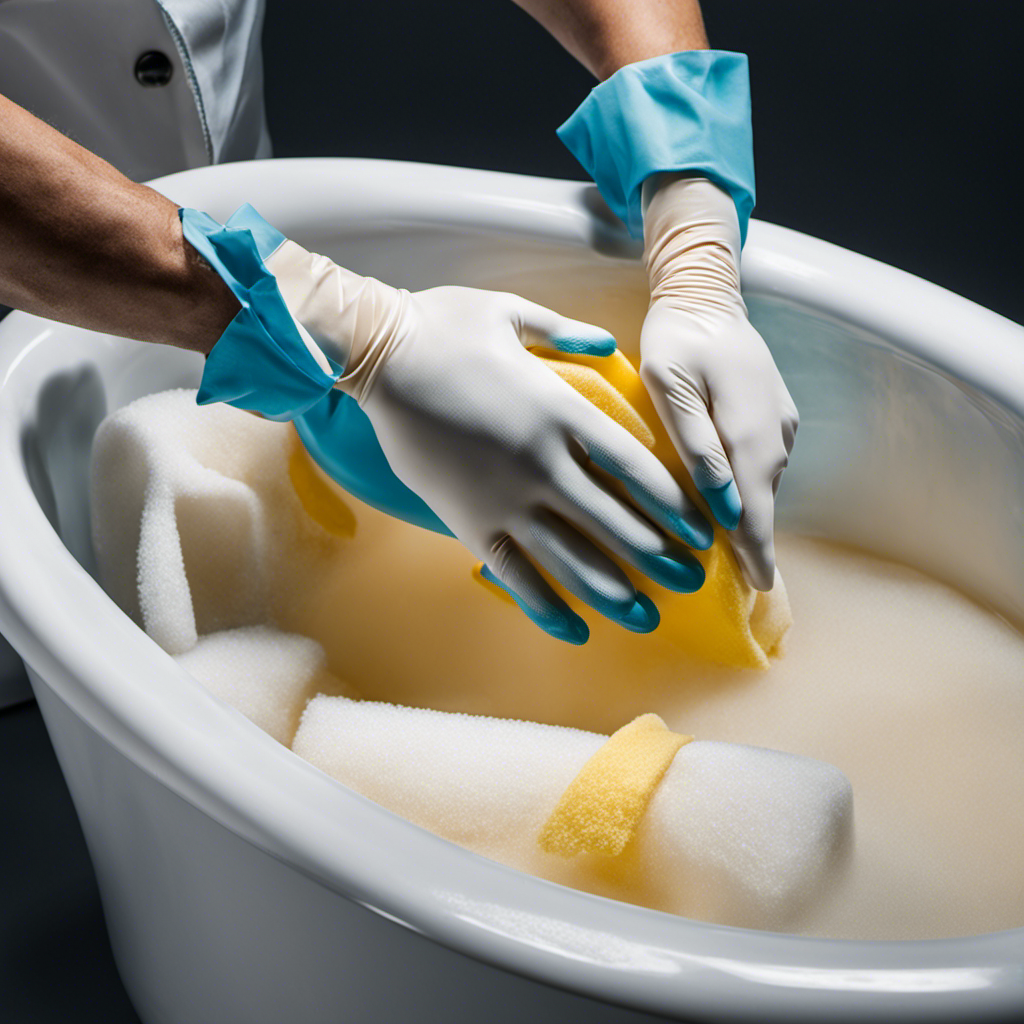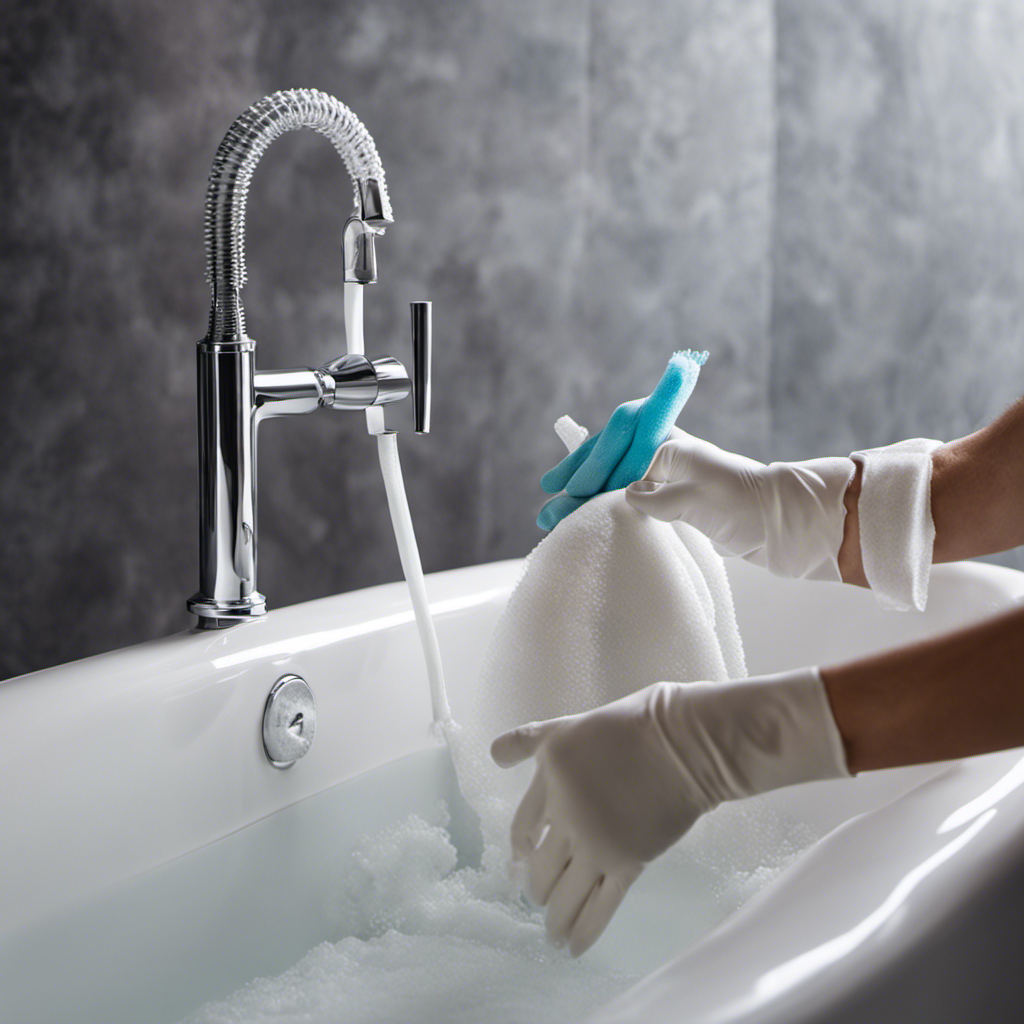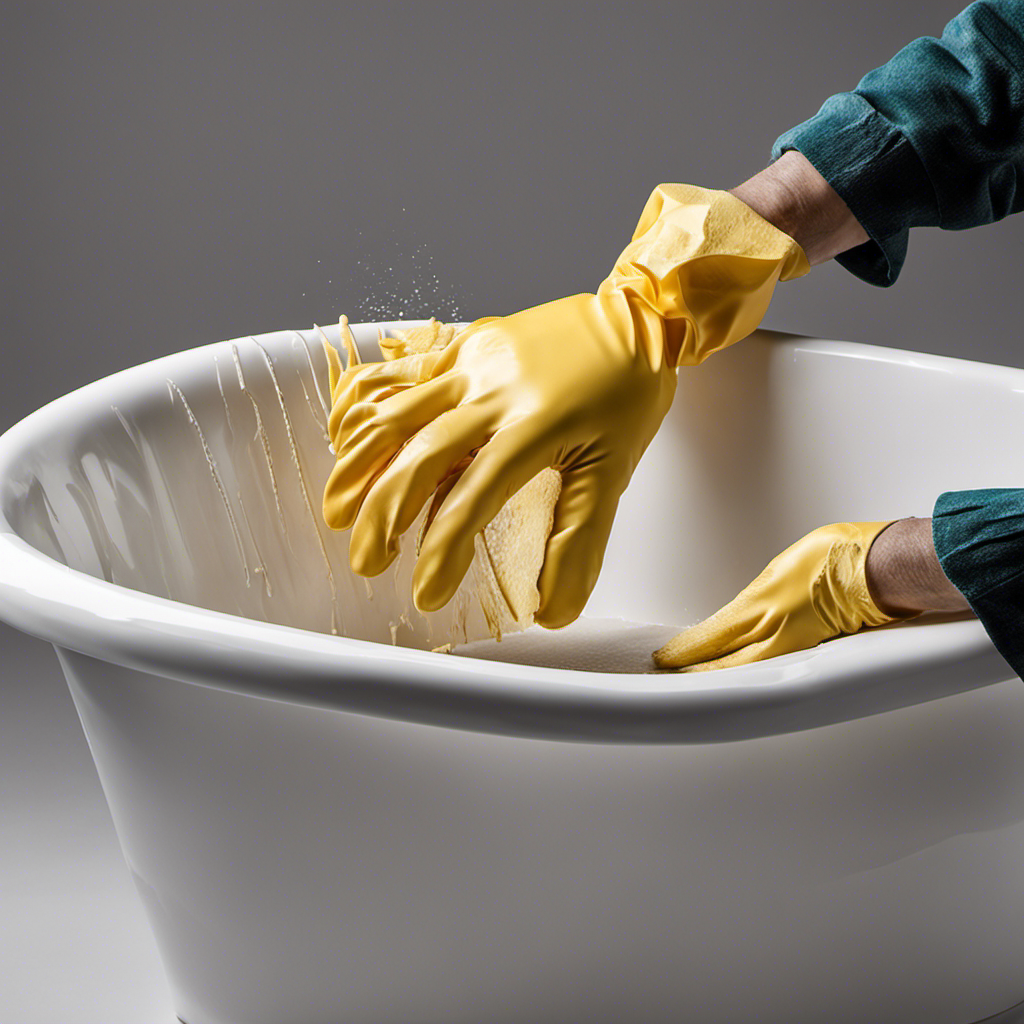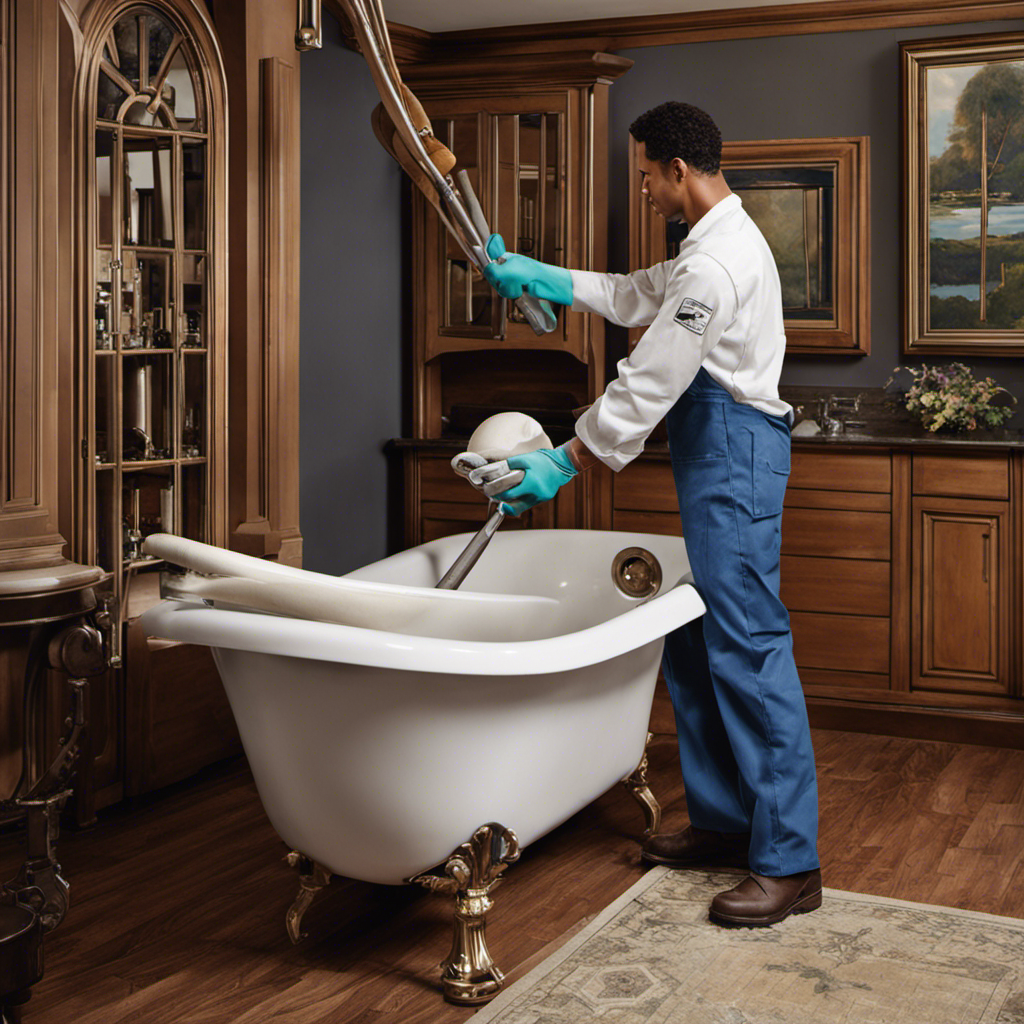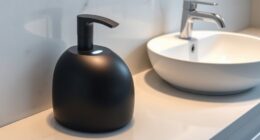Are you tired of staring at a grimy plastic bathtub every time you step into your bathroom? Well, fret no more! We’ve got the ultimate guide on how to clean that stubborn dirt and grime off your plastic bathtub.
In just a few simple steps, you’ll have a sparkling clean tub that looks brand new. So, roll up your sleeves and get ready to say goodbye to those unsightly stains. It’s time to bring back the shine to your plastic bathtub!
Key Takeaways
- Use safe and effective products for plastic bathtubs
- Avoid abrasive cleaners and harsh chemicals
- Opt for gentle cleaners designed for plastic surfaces
- Consider making your own natural cleaning solution using vinegar and baking soda
Choosing the Right Cleaning Products
You should make sure you’re using the right cleaning products for your plastic bathtub. When it comes to cleaning techniques, it’s important to choose products that are safe and effective for your bathtub’s material.
For plastic tubs, avoid using abrasive cleaners or harsh chemicals that can cause damage or discoloration. Instead, opt for gentle cleaners specifically designed for plastic surfaces. Look for eco-friendly options that are free from harsh chemicals and toxins, as they are not only better for the environment but also safer for you and your family.
You can find these products at your local store or even make your own natural cleaning solution using ingredients like vinegar and baking soda. By using the right cleaning products, you can keep your plastic bathtub looking clean and pristine for years to come.
Preparing the Bathtub for Cleaning
When it comes to preparing your bathtub for cleaning, there are three key points to keep in mind: removing surface stains, choosing the right cleaner, and taking safety precautions.
To effectively remove surface stains, you can use a variety of methods such as baking soda paste or vinegar solution.
When choosing a cleaner, make sure to consider the type of material your bathtub is made of and opt for a product that is specifically designed for that surface.
Lastly, always prioritize safety by wearing gloves, ventilating the area, and reading the instructions on the cleaner carefully to avoid any mishaps.
Removing Surface Stains
To remove surface stains from your plastic bathtub, start by mixing baking soda and water to create a paste. Apply the paste to the stained areas and let it sit for about 15 minutes. Then, scrub the stains using a soft sponge or brush in circular motions. Rinse the bathtub thoroughly with water to remove any residue. If the stains are particularly stubborn, you can also try using vinegar. Simply soak a cloth or sponge in vinegar and scrub the stains gently. Vinegar is a natural cleaning agent that can help remove deep stains from plastic bathtubs. Remember to always test these cleaning methods on a small, inconspicuous area first to ensure they do not damage the surface of your bathtub.
| Stain Type | Baking Soda & Water Paste | Vinegar Solution |
|---|---|---|
| Soap scum | ✔ | ✔ |
| Hard water stains | ✔ | ✔ |
| Rust stains | ✔ | ✔ |
Choosing the Right Cleaner
Using the right cleaner is essential for effectively removing stains from your plastic bathtub. When it comes to cleaning techniques for plastic tubs, you want to make sure you choose a cleaner that is both powerful and safe for your tub’s material.
Look for a cleaner specifically formulated for plastic surfaces, as these are designed to penetrate and lift stains without causing any damage. Additionally, consider eco-friendly options that are gentle on the environment. Many eco-friendly cleaners are made from natural ingredients, such as vinegar or baking soda, which can effectively remove stains without the use of harsh chemicals.
These cleaners not only ensure a clean and stain-free bathtub but also contribute to a healthier home and planet.
Safety Precautions to Take
It’s important to take safety precautions when choosing a cleaner for your tub. Here’s what you need to keep in mind:
- Look for non-slip properties in the cleaner to prevent accidental slips and falls.
- Check the label for any warnings or cautions related to safety.
- Wear protective gloves and eye goggles while using the cleaner to avoid any skin or eye irritation.
- Ensure proper ventilation in the bathroom by opening windows or using fans to avoid inhaling harmful fumes.
- Keep cleaning tools and equipment within reach to avoid any accidents while reaching for them.
By following these safety precautions, you can ensure a secure and hazard-free cleaning experience.
Now, let’s move on to the next step: scrubbing away stains and residue.
Scrubbing Away Stains and Residue
When it comes to scrubbing away stains and residue from your bathtub, it’s crucial to have effective cleaning products at your disposal. These products are specifically designed to tackle tough stains and remove them with ease, saving you time and effort.
Using these products can also help prevent future residue buildup, keeping your bathtub looking clean and pristine for longer periods of time.
Effective Cleaning Products
To effectively clean your plastic bathtub, you’ll need to use the right cleaning products. When it comes to choosing eco-friendly alternatives, there are natural cleaning methods that can get the job done without harsh chemicals. Here are some options you can consider:
- Baking soda: This versatile ingredient can be mixed with water to create a paste that effectively removes stains and buildup.
- Vinegar: Dilute vinegar with water and use it to scrub away grime and soap scum.
- Lemon juice: The acidity of lemon juice helps to break down tough stains and leaves a fresh scent behind.
- Castile soap: This gentle soap is made from natural ingredients and can be used to clean your bathtub without causing any harm to the environment.
- Essential oils: Add a few drops of your favorite essential oil to your cleaning solution for a pleasant aroma and added cleaning power.
By using these eco-friendly alternatives and natural cleaning methods, you can keep your plastic bathtub clean and free from harmful chemicals.
Now, let’s move on to the next section, where we’ll discuss how to remove tough stains.
Removing Tough Stains
If you’re dealing with tough stains, using a mixture of baking soda and water can effectively remove them. This natural cleaning solution is not only effective but also safe for your plastic bathtub.
To begin, mix equal parts of baking soda and water in a small bowl to create a paste. Apply the paste directly to the tough stain using a soft cloth or sponge. Gently scrub the area in circular motions, focusing on the stain.
Let the mixture sit for about 10-15 minutes to allow it to penetrate the stain. Then, rinse the area thoroughly with warm water. Repeat the process if necessary until the tough stain is completely removed.
With this simple and natural solution, you can say goodbye to those stubborn stains on your plastic bathtub.
Preventing Future Residue
One way to avoid future residue is by regularly using a mild soap to clean your tub. This simple step will prevent the buildup of soap scum, dirt, and oils, which can lead to discoloration over time.
Additionally, it is important to avoid using harsh chemicals and abrasive cleaners on your plastic bathtub, as they can cause chemical reactions that lead to further damage and discoloration.
To further prevent future residue, consider the following tips:
- Rinse the tub thoroughly after each use to remove any soap or cleaning product residue.
- Use a non-abrasive sponge or cloth to gently scrub the surface of the tub.
- Avoid using excessive amounts of cleaning products, as they can leave behind residue.
- Dry the tub completely after cleaning to prevent moisture buildup.
- Consider using a protective coating or sealant specifically designed for plastic bathtubs to maintain its original color and shine.
Removing Soap Scum and Hard Water Deposits
Start by applying a mixture of vinegar and baking soda to the soap scum and hard water deposits in your plastic bathtub. This powerful combination works wonders in removing stubborn residue. Simply sprinkle baking soda over the affected areas and then spray vinegar onto it. Allow the mixture to sit for about 15 minutes, giving it time to break down the scum and deposits. Next, scrub the surface with a non-abrasive sponge or cloth, focusing on the areas with the most buildup. Rinse thoroughly with warm water and dry with a clean towel. Repeat the process if necessary. To prevent soap scum buildup in the future, consider using a mild bathroom cleaner regularly and wiping down the tub after each use. Here are some other cleaning techniques you can try:
| Cleaning Technique | Ingredients | How to Use |
|---|---|---|
| Lemon Juice | Fresh lemon juice | Apply directly to the scum, let sit, and scrub with a sponge. Rinse thoroughly. |
| Dish Soap | Dish soap and warm water | Mix a solution of dish soap and water, scrub the surface, and rinse well. |
| Hydrogen Peroxide | Hydrogen peroxide | Apply directly to the scum, let sit for a few minutes, and scrub with a sponge. Rinse thoroughly. |
Tackling Mold and Mildew
To tackle mold and mildew in your bathroom, you can use a mixture of bleach and water. Here’s how you can do it:
-
Prepare the mixture: Mix 1 part bleach with 10 parts water in a spray bottle.
-
Ventilate the area: Open windows or turn on the exhaust fan to ensure proper ventilation.
-
Spray the affected areas: Liberally spray the bleach and water mixture onto the mold and mildew.
-
Let it sit: Allow the solution to sit for about 10-15 minutes to penetrate and kill the mold.
-
Scrub and rinse: Use a scrub brush or sponge to scrub the affected areas, then rinse thoroughly with water.
To prevent mold growth in the future, you can also try using natural cleaning solutions like vinegar or hydrogen peroxide. These solutions are effective at killing mold and mildew, and they are also safer for the environment and your health.
Regularly cleaning and drying your bathroom, especially in areas prone to moisture, will also help in preventing mold growth.
Polishing and Restoring the Plastic Surface
Using a soft cloth and a small amount of baking soda mixed with water, gently polish and restore the plastic surface of your bathtub. This simple technique can bring back the shine and remove minor scratches, leaving your tub looking brand new.
Start by wetting the cloth and then dipping it into the baking soda mixture. Next, rub the cloth onto the plastic surface in a circular motion, applying gentle pressure. The baking soda acts as a mild abrasive, effectively buffing away any imperfections.
Continue this process until you have covered the entire surface of the tub. Finally, rinse the area with clean water and dry with a soft towel.
With a little bit of effort, your plastic bathtub can be restored to its former glory.
Maintenance Tips to Keep Your Plastic Bathtub Clean
Now that you’ve learned how to polish and restore the plastic surface of your bathtub, it’s important to know how to maintain its cleanliness. By following these simple maintenance tips, you can prevent discoloration and keep your plastic bathtub looking fresh and clean:
- Regularly wipe down the bathtub with a soft cloth or sponge to remove any dirt or soap residue.
- Use a mild detergent or a mixture of vinegar and water to clean the surface and remove any grease buildup.
- Avoid using abrasive cleaners or scrub brushes that can damage the plastic.
- Rinse the bathtub thoroughly after each use to remove any leftover soap or cleaning products.
- Consider using a bath mat or non-slip stickers to prevent any scratches or damage to the surface.
Frequently Asked Questions
How Do I Choose the Right Cleaning Products for a Plastic Bathtub?
To choose the right cleaning products for a plastic bathtub, consider the material of the tub and any specific instructions from the manufacturer. Look for gentle cleaners that won’t damage the plastic.
What Are Some Tips for Preparing the Bathtub Before Cleaning?
To prepare your plastic bathtub for cleaning, start by removing any loose debris and items. Then, rinse the tub with warm water. Next, apply a suitable cleaning product and let it sit for a few minutes before scrubbing with a non-abrasive sponge.
How Can I Effectively Scrub Away Tough Stains and Residue From a Plastic Bathtub?
To effectively scrub away tough stains and residue from your plastic bathtub, you can try some effective cleaning techniques and homemade solutions. Let’s explore some tried-and-true methods that will leave your bathtub looking fresh and clean.
What Are Some Effective Methods for Removing Soap Scum and Hard Water Deposits From a Plastic Bathtub?
To remove soap scum and hard water deposits from your plastic bathtub, try these effective methods. Scrub stubborn stains with a mixture of baking soda and vinegar, and prevent soap scum buildup by wiping the tub dry after each use.
How Can I Tackle Mold and Mildew Growth in a Plastic Bathtub?
To prevent mold and mildew in your plastic bathtub, it’s important to practice good maintenance. Regularly clean the bathtub with a mixture of bleach and water, and ensure the bathroom is well-ventilated to prevent moisture buildup.
Conclusion
In conclusion, keeping your plastic bathtub clean and well-maintained is essential for a sparkling bathroom.
By choosing the right cleaning products and following a thorough cleaning routine, you can easily remove stains, soap scum, and mold from the surface.
Did you know that according to a study by the American Cleaning Institute, 80% of households prefer using plastic bathtubs?
With regular maintenance, your plastic bathtub can remain in pristine condition for years to come, ensuring a relaxing and hygienic bathing experience.
